1x1 Rotary Joint for FC/PC Multimode Patch Cables
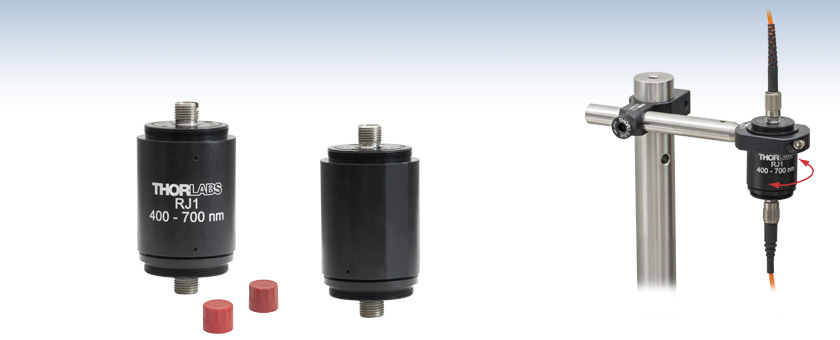
Back View
RJ1
Compatible with FC/PC Connectors
Flat Edge to Prevent Rolling when Placed on a Table
Application Idea
Mount the RJ1 Rotary Joint vertically by using a SM1RC lens tube slip ring, an RA90RS adapter, and Ø1/2" and Ø1" posts.
Front View
- <±3.0% Rotational Variation over 400 - 700 nm Range
- Protects Against Fiber Damage from Moving Specimen
- Recommended for FC/PC Patch Cables with ≥Ø200 μm Core, 0.22 to 0.50 NA

Please Wait
| Specificationsa | ||
|---|---|---|
| Operating Wavelength | 400 - 700 nm | |
| Transmission | LED | >60% (Typical) |
| Laser | >70% (Typical) | |
| Rotational Variation of Transmission | ±3.0% (Max) ±1.5% (Typical) |
|
| Start-Up Torque | <150 µN·m | |
| Recommended Fiber Core Diameter | ≥Ø200 µm | |
| Recommended Fiber NA | 0.22 - 0.50 NA | |
Features
- Protects Against Fiber Damage Caused by Moving Specimen
- Accepts Both Wide (2.2 mm) and Narrow-Key (2.0 mm) FC/PC Patch Cables
- Consistent Performance over 400 - 700 nm Wavelength Range
- Low Transmission Variation During Rotation (See Performance Tab)
- Precision Bearings Provide Extremely Smooth Rotation
- Recommended for ≥Ø200 µm Core, 0.22 to 0.50 NA Patch Cablesa
- Designed and Tested for Use with a Multimode Laser or Fiber-Coupled LED
- Externally SM1-Threaded Housing for Secure Mounting
- Bidirectional Device
Thorlabs' RJ1 1x1 Rotary Joint for FC/PC Multimode Patch Cables is a single input and output rotary joint with low rotational variation. Designed for use in optogenetics, the rotary interface allows patch cables to rotate freely when attached to a moving specimen, reducing the risk of both fiber damage and intensity fluctuations. Since patch cables are not permanently attached to the RJ1 rotary joint, damaged fibers can be replaced easily. This also allows for more flexibility than a one-piece solution, since the patch cables can be selected with a specific core, NA, and jacketing type to optimize an experiment. In particular, the input patch cable can be selected to match a specific excitation LED or laser source, while the ferrule of the output patch cable can be chosen to match a specific cannula size.

Click to Enlarge
RJ1 1x1 rotary joint insertion loss measured using a SLS201 Light Source and an optical spectrum analyzer. The shaded region indicates the operating range.
Optical Design
This rotary joint has been extensively tested for use with both LED and multimode laser light sources, as well as patch cables commonly used in optogenetics applications. By design, when a fiber is inserted into either end of the rotary joint, the fiber tip is at the focal point of the collimating lenses. These large NA, color-corrected lenses provide achromatic performance and are well suited for use with LED sources that overfill the fiber NA. The RJ1 rotary joint is bidirectional and provides a typical total LED transmission of 60% that varies less than ±3.0% with rotation.
The RJ1 rotary joint is tested and aligned during assembly using Ø200 µm core, 0.39 NA fiber patch cables and a previous-generation M470F3 470 nm Fiber-Coupled LED. Thorlabs can provide custom rotary joints that are aligned and optimized using other patch cables or light sources; please contact Tech Support with inquiries.
Mechanical Construction
The mechanical design of the RJ1 rotary joint incorporates several features that help produce consistent optical performance across most application requirements. It includes precision bearings for extremely smooth rotation, long lifetime, and low signal strength variations as the joint rotates. A low start-up torque of <150 µN·m ensures that the joint will rotate freely as the specimen moves. The input and output ports have a high-tolerance insert that enables repeatable and optimized alignment between patch cables and rotary joint. A flat surface on one side of the housing allows a user to rest the RJ1 rotary joint on a table without rolling.
Thorlabs offers several options for mounting that allow the rotary joint to be held vertically. The rotary joint features external SM1 (1.035"-40) mounting threads on the input side for compatibility with our SM1-threaded fixed mounts. Alternatively, it can also be mounted directly via the Ø1.20" body using our SM1TC lens tube clamp or SM1RC lens tube slip ring. These mounting methods can connect directly to our optical post assemblies, which provide options for mounting and positioning that can meet the needs of many experimental configurations.
Patch Cable Compatibility
The input and output ports of the RJ1 rotary joint accept 2.0 mm narrow key and 2.2 mm wide key FC/PC connectors. For optimal performance, we recommend using multimode patch cables with a core diameter ≥Ø200 µm and NA between 0.22 to 0.50 (see the Performance tab for test data). Please note that the specifications of the RJ1 rotary joint are not guaranteed for Ø200 µm core, 0.22 NA, single-clad fibers and those with a second TECS-based cladding, like the FG200LCC and FG200UCC, should be used instead.
For compatibility with our fiber-coupled LED sources, use a multimode hybrid patch cable with an FC/PC connector on one end and an SMA905 connector on the other end to connect the LED. On the output end, FC/PC optogenetics patch cables offer compatibility with our Ø1.25 mm and Ø2.5 mm cannulae via an interconnect or mating sleeve.
To meet the performance specifications, fiber ends and connectors must be clean; dust or other contaminants will increase the rotational variance and decrease transmission. Thorlabs offers a complete line of fiber cleaning products specifically designed for terminated fibers, fiber connectors, and fiber bulkheads.
Optogenetics Product Family for In Vivo Applications
Thorlabs offers a wide variety of products designed to support in vivo optogenetics applications. Please visit the OG Selection Guide tab above to see a full listing of available products for different applications.


Click to Enlarge
The RJ1 rotary joint is a bidirectional device. The schematic shows the orientiation used for performance testing.
Typical Performance Data and Comparison
For optogenetics applications, the intensity and stability of light that reaches a specimen is determined by how the transmission through a rotary joint changes with rotation. This can also be affected by the core diameter and NA of the connected patch cables, as well as the wavelength and beam divergence of the light source.
In the graphs below, we show the typical transmission and variance of the RJ1 rotary joint with combinations of seven patch cable types and three light sources. The three light sources used in this test are the previous-generation M470F3 470 nm LED, S1FC473MM 473 nm Multimode Laser, and a M590F3 590 nm LED. These test results indicate that the RJ1 rotary joint has consistent performance across multiple fiber types and input light sources. In general, higher transmission and lower rotational variation is observed when the RJ1 rotary joint is used with larger core diameter fibers. We also compare the transmission through the RJ1 rotary joint with that of a non-Thorlabs rotary joint. In our tests, the RJ1 rotary joint provides higher transmission when used with a 590 nm LED light source, as well as greater stability as the fiber core size or NA changes. The raw data for the graphs can be viewed by clicking on the yellow bar below.
Please note that the specifications of the RJ1 rotary joint are guaranteed only for multimode 0.39 NA, 0.50 NA, and dual-clad 0.22 NA fibers with core diameters ≥Ø200 µm. If single-clad Ø200 µm core, 0.22 NA fibers are used with the RJ1 rotary joint, performance specifications will not be met, as shown in the graphs below. For fiber with a Ø200 µm core size and 0.22 NA, we recommend using dual-clad fibers that have a TECS-based outer cladding, like the FG200LCC and FG200UCC, on the output (green data points) or both the input and output (blue data points). Details about the specific fibers used for testing can be viewed by clicking on the yellow bar below.
Transmission through the RJ1 rotary joint was measured using a PM120D digital power meter with a S120-FC fiber adapter. The data shown below reflects the typical performance of the RJ1 rotary joint. Though variation in the performance of each individual rotary joint is expected, the specified transmission and rotational variance are guaranteed for the recommended core sizes, NAs, and cladding types. Data for Ø105 µm core, 0.22 NA fibers is provided as a reference, as these fibers are not within the range of recommended core sizes; performance with Ø105 µm core patch cables is not guaranteed.
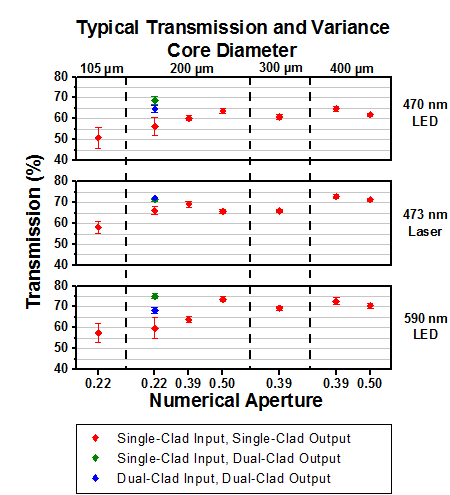
Click to Enlarge
Plot of the output transmission as a percent of the total light input to the RJ1 rotary joint. The error bars indicate the measured variance due to rotation as the rotary joint spins. The joint was tested with three different configurations of Ø200 μm core, 0.22 NA fiber: single-clad for the input and output legs, single-clad input and dual-clad output, and dual-clad input and output. Best performance was reached when a dual-clad fiber was connected for the output.

Click to Enlarge
Comparison of total transmission through the RJ1 rotary joint (red) and a non-Thorlabs rotary joint (black) when used with a variety of light sources and patch cables. The RJ1 rotary joint provides higher transmission when used with a 590 nm LED, as well as more stable performance when used with a variety of patch cables. Fibers at the input and output of the rotary joints were single clad for all measurements except for the Ø200 µm core, 0.22 NA case, where dual-clad fibers were used.
Click Here for Typical Performance Raw Data
| Fiber Core Diameter |
Fiber NA | Input Patch Cablea | Output Patch Cable | Light Source | RJ1 Rotary Joint | Non-Thorlabs Rotary Joint | ||
|---|---|---|---|---|---|---|---|---|
| Average Transmission | Rotational Variation | Average Transmission | Rotational Variation | |||||
| 105 µmb | 0.22 | M43L01 | M61L01 | 473 nm Laser | 58.2% | 2.9% | 14.6% | 5.3% |
| M18L01 | 470 nm LED | 51.0% | 5.0% | 66.1% | 12.4% | |||
| 590 nm LED | 57.5% | 4.5% | 50.6% | 3.8% | ||||
| 200 µmc | 0.22 | M122L01 | M122L01 | 473 nm Laser | 66.1% | 1.9% | 57.1% | 4.9% |
| M91L01 | 470 nm LED | 56.4% | 4.2% | 67.4% | 7.0% | |||
| 590 nm LED | 59.8% | 5.0% | 60.6% | 3.1% | ||||
| 200 µmd | 0.22 | M122L01 | M84L01 | 473 nm Laser | 71.5% | 0.7% | 74.9% | 0.3% |
| M91L01 | 470 nm LED | 68.8% | 2.0% | 73.5% | 1.5% | |||
| 590 nm LED | 75.1% | 1.1% | 72.3% | 1.1% | ||||
| 200 µme | 0.22 | M132L01 | M84L01 | 473 nm Laser | 72.4% | 0.8% | 42.3% | 1.0% |
| M133L01 | 470 nm LED | 64.4% | 1.7% | 71.6% | 2.1% | |||
| 590 nm LED | 68.2% | 1.5% | 58.0% | 0.5% | ||||
| 200 µm | 0.39 | M72L01 | M81L01 | 473 nm Laser | 69.4% | 1.4% | 92.0% | 3.1% |
| M75L01 | 470 nm LED | 60.2% | 1.2% | 66.1% | 3.5% | |||
| 590 nm LED | 63.8% | 1.4% | 50.9% | 1.4% | ||||
| 200 µm | 0.5 | M123L01 | M104L01 | 473 nm Laser | 65.8% | 0.9% | 57.7% | 3.2% |
| M129L01 | 470 nm LED | 63.8% | 1.3% | 51.4% | 3.0% | |||
| 590 nm LED | 73.6% | 1.2% | 45.7% | 1.1% | ||||
| 300 µm | 0.39 | M69L01 | M56L01 | 473 nm Laser | 66.1% | 0.9% | 81.7% | 1.8% |
| M12L01 | 470 nm LED | 60.9% | 1.2% | 68.0% | 1.8% | |||
| 590 nm LED | 69.4% | 1.0% | 62.8% | 1.3% | ||||
| 400 µm | 0.39 | M74L01 | M82L01 | 473 nm Laser | 72.8% | 0.9% | 74.8% | 2.1% |
| M76L01 | 470 nm LED | 64.8% | 1.1% | 58.5% | 4.3% | |||
| 590 nm LED | 72.6% | 1.7% | 68.2% | 3.2% | ||||
| 400 µm | 0.5 | M124L01 | M128L01 | 473 nm Laser | 75.1% | 0.7% | 78.9% | 0.7% |
| M131L01 | 470 nm LED | 62.0% | 0.7% | 74.0% | 0.3% | |||
| 590 nm LED | 70.5% | 1.1% | 67.3% | 0.2% | ||||

Click to Enlarge
Typical transmission for the RJ1 rotary joint measured using different fiber-coupled LEDs and a PM120D power meter. Error bars indicate the measured variation in transmission due to joint rotation as it spins. This data is measured using Ø200 μm core, 0.39 NA fiber patch cables.
| LED Item # | Wavelengtha | Typical Opsin |
|---|---|---|
| M470F3b | 470 nm | ChR2, ChR2-SFO |
| M490F3b | 490 nm | Rh-CT, ChR2 (E123A) |
| M505F1 | 505 nm | ChRGR, Opto-α1AR, Opto-β2AR |
| M530F2 | 530 nm | C1V1, VChR1 |
| M565F3 | 565 nm | Arch, VChR1-SFO |
| M590F3 | 590 nm | ChR2-SFO, eNpHR3.0 |
| M625F2 | 625 nm | ReChR |
LED Performance
Thorlabs' fiber-coupled LEDs and drivers are well suited for integration into optogenetics experimental setups. During in vivo procedures, light from one or two LED sources is coupled into a fiber optic cannula, implanted in a specimen, where it is used to excite opsin proteins sensitive to the emitted light. LEDs are commonly used for these stimulation experiments as they provide high-power output over a broad range of wavelengths and exhibit superior illumination homogeneity to lasers.
The graph to right shows typical LED transmission through the RJ1 rotary joiny when different fiber-coupled LEDs (listed in the table to the right) are used as the light source. Patch cables using Ø200 µm, 0.39 NA multimode fiber were used for the input and output. Transmission through the RJ1 rotary joint was measured using a PM120D digital power meter with a S120-FC fiber adapter.

Click to Enlarge
Total Internal Reflection in an Optical Fiber
Guiding Light in an Optical Fiber
Optical fibers are part of a broader class of optical components known as waveguides that utilize total internal reflection (TIR) in order to confine and guide light within a solid or liquid structure. Optical fibers, in particular, are used in numerous applications; common examples include telecommunications, spectroscopy, illumination, and sensors.
One of the more common glass (silica) optical fibers uses a structure known as a step-index fiber, which is shown in the image to the right. Step-index fibers have an inner core made from a material with a refractive index that is higher than the surrounding cladding layer. Within the fiber, a critical angle of incidence exists such that light will reflect off the core/cladding interface rather than refract into the surrounding medium. To fulfill the conditions for TIR in the fiber, the angle of incidence of light launched into the fiber must be less than a certain angle, which is defined as the acceptance angle, θacc. Snell's law can be used to calculate this angle:
![]()

where ncore is the refractive index of the fiber core, nclad is the refractive index of the fiber cladding, n is the refractive index of the outside medium, θcrit is the critical angle, and θacc is the acceptance half-angle of the fiber. The numerical aperture (NA) is a dimensionless quantity used by fiber manufacturers to specify the acceptance angle of an optical fiber and is defined as:

In step-index fibers with a large core (multimode), the NA can be calculated directly using this equation. The NA can also be determined experimentally by tracing the far-field beam profile and measuring the angle between the center of the beam and the point at which the beam intensity is 5% of the maximum; however, calculating the NA directly provides the most accurate value.
Number of Modes in an Optical Fiber
Each potential path that light propagates through in an optical fiber is known as a guided mode of the fiber. Depending on the physical dimensions of the core/cladding regions, refractive index, and wavelength, anything from one to thousands of modes can be supported within a single optical fiber. The two most commonly manufactured variants are single mode fiber (which supports a single guided mode) and multimode fiber (which supports a large number of guided modes). In a multimode fiber, lower-order modes tend to confine light spatially in the core of the fiber; higher-order modes, on the other hand, tend to confine light spatially near the core/cladding interface.
Using a few simple calculations, it is possible to estimate the number of modes (single mode or multimode) supported by an optical fiber. The normalized optical frequency, also known as the V-number, is a dimensionless quantity that is proportional to the free space optical frequency but is normalized to guiding properties of an optical fiber. The V-number is defined as:
![]()
where V is the normalized frequency (V-number), a is the fiber core radius, and λ is the free space wavelength. Multimode fibers have very large V-numbers; for example, a Ø50 µm core, 0.39 NA multimode fiber at a wavelength of 1.5 µm has a V-number of 40.8.
For multimode fiber, which has a large V-number, the number of modes supported is approximated using the following relationship.
![]()
In the example above of the Ø50 µm core, 0.39 NA multimode fiber, it supports approximately 832 different guided modes that can all travel simultaneously through the fiber.
Single mode fibers are defined with a V-number cut-off of V < 2.405, which represents the point at which light is coupled only into the fiber's fundamental mode. To meet this condition, a single mode fiber has a much smaller core size and NA compared to a multimode fiber at the same wavelength. One example of this, SMF-28 Ultra single mode fiber, has a nominal NA of 0.14 and an Ø8.2 µm core at 1550 nm, which results in a V-number of 2.404.

Click to Enlarge
Attenuation Due to Macrobend Loss
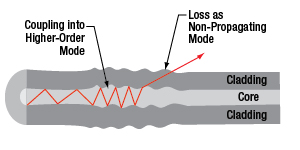
Click to Enlarge
Attenuation Due to Microbend Loss
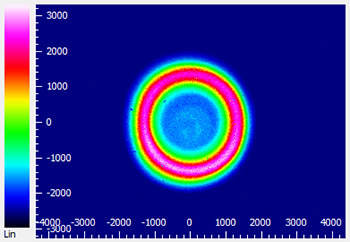
Click to Enlarge
Beam profile measurement of FT200EMT multimode fiber and a former generation M565F1 LED (replaced by the M565F3) showing light guided in the cladding rather than the core of the fiber.
Sources of Attenuation
Loss within an optical fiber, also referred to as attenuation, is characterized and quantified in order to predict the total transmitted power lost within a fiber optic setup. The sources of these losses are typically wavelength dependent and range from the material used in the fiber itself to bending of the fiber. Common sources of attenuation are detailed below:
Absorption
Because light in a standard optical fiber is guided via a solid material, there are losses due to absorption as light propagates through the fiber. Standard fibers are manufactured using fused silica and are optimized for transmission from 1300 nm to 1550 nm. At longer wavelengths (>2000 nm), multi-phonon interactions in fused silica cause significant absorption. Fluoride glasses such as ZrF4 and InF3 are used in manufacturing Mid-IR optical fibers primarily because they exhibit lower loss at these wavelengths. ZrF4 and InF3 fibers have a multi-phonon edge of ~3.6 µm and ~4.6 µm, respectively.
Contaminants in the fiber also contribute to the absorption loss. One example of an undesired impurity is water molecules that are trapped in the glass of the optical fiber, which will absorb light around 1300 nm and 2.94 µm. Since telecom signals and some lasers operate in that same region, any water molecules present in the fiber will attenuate the signal significantly.
The concentration of ions in the fiber glass is often controlled by manufacturers to tune the transmission/attenuation properties of a fiber. For example, hydroxyl ions (OH-) are naturally present in silica and absorb light in the NIR-IR spectrum. Therefore, fibers with low-OH content are preferred for transmission at telecom wavelengths. On the other hand, fibers with high-OH content typically exhibit increased transmission at UV wavelengths and thus may be preferred by users interested in applications such as fluorescence or UV-VIS spectroscopy.
Scattering
For the majority of fiber optics applications, light scattering is a source of loss that occurs when light encounters a change in the refractive index of the medium. These changes can be extrinsic, caused by impurities, particulates, or bubbles; or intrinsic, caused by fluctuations in the glass density, composition, or phase state. Scattering is inversely related to the wavelength of light, so scattering loss becomes significant at shorter wavelengths such as the UV or blue regions of the spectrum. Using proper fiber cleaning, handling, and storage procedures may minimize the presence of impurities on tips of fibers that cause large scattering losses.
Bending Loss
Losses that occur due to changes in the external and internal geometry of an optical fiber are known as bending loss. These are usually separated into two categories: macrobending loss and microbending loss.
Macrobend loss is typically associated with the physical bending of an optical fiber; for example, rolling it in a tight coil. As shown in the image to the right, guided light is spatially distributed within the core and cladding regions of the fiber. When a fiber is bent at a radius, light near the outer radius of the bend cannot maintain the same spatial mode profile without exceeding the speed of light. Instead, the energy is lost to the surroundings as radiation. For a large bend radius, the losses associated with bending are small; however, at bend radii smaller than the recommended bend radius of a fiber, bend losses become very significant. For short periods of time, optical fibers can be operated at a small bend radius; however, for long-term storage, the bend radius should be larger than the recommended value. Use proper storage conditions (temperature and bend radius) to reduce the likelihood of permanently damaging the fiber; the FSR1 Fiber Storage Reel is designed to minimize high bend loss.
Microbend loss arises from changes in the internal geometry of the fiber, particularly the core and cladding layers. These random variations (i.e., bumps) in the fiber structure disturb the conditions needed for total internal reflection, causing propagating light to couple into a non-propagating mode that leaks from the fiber (see the image to the right for details). Unlike macrobend loss, which is controlled by the bend radius, microbend loss occurs due to permanent defects in the fiber that are created during fiber manufacturing.
Cladding Modes
While most light in a multimode fiber is guided via TIR within the core of the fiber, higher-order modes that guide light within both the core and cladding layer, because of TIR at the cladding and coating/buffer interface, can also exist. This results in what is known as a cladding mode. An example of this can be seen in the beam profile measurement to the right, which shows cladding modes with a higher intensity in the cladding than in the core of the fiber. These modes can be non-propagating (i.e., they do not fulfill the conditions for TIR) or they can propagate over a significant length of fiber. Because cladding modes are typically higher-order, they are a source of loss in the presence of fiber bending and microbending defects. Cladding modes are also lost when connecting two fibers via connectors as they cannot be easily coupled between optical fibers.
Cladding modes may be undesired for some applications (e.g., launching into free space) because of their effect on the beam spatial profile. Over long fiber lengths, these modes will naturally attenuate. For short fiber lengths (<10 m), one method for removing cladding modes from a fiber is to use a mandrel wrap at a radius that removes cladding modes while keeping the desired propagating modes.
Launch Conditions
Underfilled Launch Condition
For a large multimode fiber which accepts light over a wide NA, the condition of the light (e.g., source type, beam diameter, NA) coupled into the fiber can have a significant effect on performance. An underfilled launch condition occurs when the beam diameter and NA of light at the coupling interface are smaller than the core diameter and NA of the fiber. A common example of this is launching a laser source into a large multimode fiber. As seen in the diagram and beam profile measurement below, underfilled launches tend to concentrate light spatially in the center of the fiber, filling lower-order modes preferentially over higher-order modes. As a result, they are less sensitive to macrobend losses and do not have cladding modes. The measured insertion loss for an underfilled launch tends to be lower than typical, with a higher power density in the core of the fiber.
Overfilled Launch Condition
Overfilled launches are defined by situations where the beam diameter and NA at the coupling interface are larger than the core diameter and NA of the fiber. One method to achieve this is by launching light from an LED source into a small multimode fiber. An overfilled launch completely exposes the fiber core and some of the cladding to light, enabling the filling of lower- and higher-order modes equally (as seen in the images below) and increasing the likelihood of coupling into cladding modes of the fiber. This increased percentage of higher-order modes means that overfilled fibers are more sensitive to bending loss. The measured insertion loss for an overfilled launch tends to be higher than typical, but results in an overall higher output power compared to an underfilled fiber launch.
There are advantages and disadvantages to underfilled or overfilled launch conditions, depending on the needs of the intended application. For measuring the baseline performance of a multimode fiber, Thorlabs recommends using a launch condition where the beam diameter is 70-80% of the fiber core diameter. Over short distances, an overfilled fiber has more output power; however, over long distances (>10 - 20 m) the higher-order modes that more susceptible to attenuation will disappear.
| Posted Comments: | |
| No Comments Posted |
| Quick Links | |||
|---|---|---|---|
| Single-Site Stimulation | |||
| One Light Source to One Cannula Implant | |||
| Multilateral Stimulation | |||
| One Light Source to Two Cannula Implants Using Rotary Joint Splitter | |||
| One or Two Light Sources to Two Cannula Implants | |||
| One Light Source to Seven Cannula Implants | |||
| Two Light Sources into One Dual-Core Cannula Implant | |||
| Illumination | |||
| Fiber-Coupled LEDs and Drivers | |||
Optogenetics Selection Guide
Thorlabs offers a wide range of optogenetics components; the compatibility of these products in select standard configurations is discussed in detail here. Please contact Technical Support for assistance with items outside the scope of this guide, including custom fiber components for optogenetics.
Single-Site Stimulation
One Light Source to One Cannula Implant
The most straightforward method for in vivo light stimulation of a specimen is to use a single fiber optic with a single LED light source. The single wavelength LED is powered by an LED driver, and then the illumination output is fiber-coupled into a patch cable, which connects to the implanted cannula. See the graphics and expandable compatibility tables below for the necessary patch cables and cannulae to create this setup. To choose the appropriate LED and driver, see below or the full web presentation.
Click on Each Component for More Information

Click to See Ø1.25 mm (LC) Ferrule Compatible Patch Cables, Cannulae, and Interconnects
Click to See Ø2.5 mm (FC) Ferrule Compatible Patch Cables, Cannulae, and Interconnects
Multilateral Stimulation
The ability to accurately and simultaneously direct light to multiple locations within a specimen is desired for many types of optogenetics experiments. For example, bilateral stimulation techniques typically target neurons in two spatially separated regions in order to induce a desired behavior. In more complex experiments involving the simultaneous inhibition and stimulation of neurons, delivering light of two different monochromatic wavelengths within close proximity enables the user to perform these experiments without implanting multiple cannulae, which can increase stress on the specimen.
Multilateral stimulation can be achieved with several different configurations depending on the application requirements. The sections below illustrate examples of different configurations using Thorlabs' optogenetics products.
Option 1: One Light Source to Two Cannula Implants Using Rotary Joint Splitter
Thorlabs' RJ2 1x2 Rotary Joint Splitter is designed for optogenetics applications and is used to split light from a single input evenly between two outputs. The rotary joint interface allows connected patch cables to freely rotate, reducing the risk of fiber damage caused by a moving specimen. See the graphic and compatibility table below for the necessary cables and cannulae to create this setup. For LEDs and drivers, see below or the full web presentation.

Click to See Ø1.25 mm (LC) Ferrule Components Recommended for Use with RJ2 Rotary Joint Splitter
Click to See Ø2.5 mm (FC) Ferrule Components Recommended for Use with RJ2 Rotary Joint Splitter
Option 2: One or Two Light Sources to Two Cannula Implants
If the intent is for one LED source to connect to two cannulae for simultaneous light modulation, then a bifurcated fiber bundle can be used to split the light from the LED into each respective cannula. For dual wavelength stimulation (mixing two wavelengths in a single cannula) or a more controlled split ratio between cannula, one can use a multimode coupler to connect one or two LEDs to the cannulae. If one cable end is left unused, the spare coupler cable end may be terminated by a light trap. See the graphic and compatibility table below for the necessary cables and cannulae to create this setup. For LEDs and drivers, see below or the full web presentation.
Click on Each Component Below for More Information


Option 3: One Light Sources to Seven Cannula Implants
If the intent is for one LED source to connect to seven cannulae for simultaneous light modulation, then a 1-to-7 fiber bundle can be used to split the light from the LED into each respective cannula. See the graphic and compatibility table below for the necessary cables and cannulae to create this setup. For LEDs and drivers, see below or the full web presentation.
Click on Each Component Below for More Information

Two Light Sources into One Dual-Core Cannula Implant
For bilateral stimulation applications where the two cannulas need to be placed in close proximity (within ~1 mm), Thorlabs offers dual-core patch cables and cannulae that are designed for this specific application. Each core is driven by a separate light source, enabling users to stimulate and/or supress nerve cells in the same region of the specimen. See the graphic and compatibility table below for the necessary cables and cannulae to create this setup. For LEDs and drivers, see below or the full web presentation.
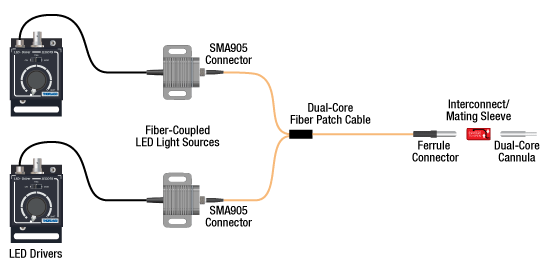
Click on Each Component for More Information
| Part Selection Table (Click Links for Item Description Popup) | |||||||||
|---|---|---|---|---|---|---|---|---|---|
| Common Fiber Properties | |||||||||
| Core Diameter | 200 µm | ||||||||
| Wavelength Range | 400 - 2200 nm | ||||||||
| NA | 0.39 | ||||||||
| Fiber Type | FT200EMT | ||||||||
| Ferrule Stylea | FC (Ø2.5 mm) | ||||||||
| Dual-Core Patch Cable | FC/PC Input | BFY32FL1 | |||||||
| SMA905 Input | BFY32SL1 | ||||||||
| Compatible Mating Sleeve/Interconnect | ADAF1 ADAF2 ADAF4-5 |
||||||||
| Dual-Core Fiber Optic Cannulaec | Stainless Steel | CFM32L10 CFM32L20 |
|||||||
| LED Item # | Wavelengtha | Typical Opsin | Output Powerb | Color |
|---|---|---|---|---|
| M405F3c | 405 nm | mmilCFP, hcriGFP | 3.7 mW | UV |
| M430F1 | 430 nm | ChR2 | 7.5 mW | Violet |
| M455F3 | 455 nm | ChIEF, bPAC | 24.5 mW | Royal Blue |
| M470F4 | 470 nm | ChR2, ChR2-SFO | 20 mW | Blue |
| M490F4 | 490 nm | Rh-CT, ChR2 (E123A) | 2.8 mW | Blue |
| M505F3 | 505 nm | ChRGR, Opto-α1AR, Opto-β2AR | 11.7 mW | Cyan |
| M530F3 | 530 nm | C1V1, VChR1 | 9.6 mW | Green |
| M565F3 | 565 nm | Arch, VChR1-SFO | 13.5 mW | Lime |
| M595F2 | 595 nm | ChR2-SFO, eNpHR3.0 | 11.5 mW | Amber |
| M625F2 | 625 nm | ReChR | 17.5 mW | Red |
Illumination
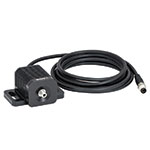
Click to Enlarge
M405F1
Fiber-Coupled LEDs and Drivers
Our fiber-coupled LEDs are ideal light sources for optogenetics applications. They feature a variety of wavelength choices and a convenient interconnection to optogenetics patch cables. Thorlabs offers fiber-coupled LEDs with nominal wavelengths ranging from 280 nm to 1050 nm. See the table to the right for the LEDs with the most popular wavelengths for optogenetics. A table of compatible LED drivers can be viewed by clicking below.
 Products Home
Products Home


















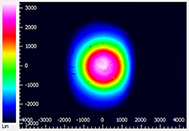


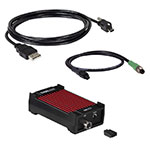

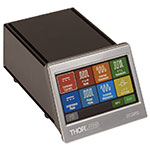
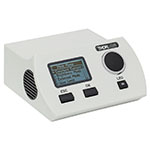



 1x1 Rotary Joint
1x1 Rotary Joint